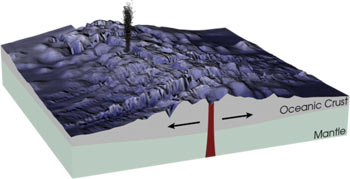 |
| Merentutkimuksen terminologiaa kuva wikimedia |
Lainaan tähän tekstiä wikipedian lyhyestä artikkelista Seabed
Merenpohjan rakenne
 |
| Merenpohjan harjanne ja syvän meren venttiili kuva wikimedia |
Most of the oceans have a common structure, created by common physical phenomena, mainly from
The structure of the oceans, starting with the continents, begins usually with a continental shelf, continues to the continental slope – which is a steep descent into the ocean, until reaching the abyssal plain – a topographic plain, the beginning of the seabed, and its main area.
- tectonic movement, and
- sediment from various sources.
The border between the continental slope and the abyssal plain usually has a more gradual descent, and is called the continental rise, which is caused by sediment cascading down the continental slope.
The mid-ocean ridge, as its name implies, is a mountainous rise through the middle of all the oceans, between the continents. Typically a rift runs along the edge of this ridge.
Along tectonic plate edges there are typically oceanic trenches – deep valleys, created by the mantle circulation movement from the mid-ocean mountain ridge to the oceanic trench.
Hotspot volcanic island ridges are created by volcanic activity, erupting periodically, as the tectonic plates pass over a hotspot.
In areas with volcanic activity and in the oceanic trenches there are hydrothermal vents – releasing high pressure and extremely hot water and chemicals into the typically freezing water around it.
Merenpohjan piirteitä
Each area of the seabed has typical features such as
- common soil composition,
- typical topography,
- salinity of water layers above it,
- marine life,
- magnetic direction of rocks, and
- sedimenting.
Seabed topography is flat where sedimenting is heavy and covers the tectonic features. Sedimenting comes from various sources:
- Land erosion sediments, brought mainly by rivers,
- New "young rock" – New magma of basalt composition, from the mid-ocean ridge.
- Underwater volcanic ash spreading, especially from hydrothermal vents.
- Microorganism activity.
- Sea currents eroding the seabed itself,
- Marine life: corals, fish, algae, crabs, marine plants and other biological created sediment.
Where sedimenting is avoided, such as in the Atlantic ocean especially in the northern and eastern Atlantic, the original tectonic activity can be clearly seen as straight line "cracks" or "vents" thousands of kilometers long.
Brine pools are another seabed feature, usually connected to cold seeps.
Merenpohjan elämää
Benthos
Benthos is the community of organisms which live on, in, or near the seabed, the area known as the benthic zone.
This community lives in or near marine sedimentary environments, from tidal pools along the foreshore, out to the continental shelf, and then down to the abyssal depths.
The benthic zone is the ecological region on, in and immediately above the seabed, including the sediment surface and some sub-surface layers. Benthos generally live in close relationship with the substrate bottom, and many such organisms are permanently attached to the bottom.
The superficial layer of the soil lining the given body of water, the benthic boundary layer, is an integral part of the benthic zone, and greatly influences the biological activity which takes place there. Examples of contact soil layers include sand bottoms, rocky outcrops, coral, and bay mud.
Savupiiput
Recently there has been the discovery of abundant marine life in the deep sea, especially around hydrothermal vents. Large deep sea communities of marine life have been discovered around black and white smokers – hydrothermal vents emitting typical chemicals toxic to humans and most of the vertebrates. This marine life receives its energy from both the extreme temperature difference (typically a drop of 150 degrees) and from chemosynthesis by bacteria.
Lainaukset kaikki wikipedia
Kommentti
Syvänmeren elämä kiinnostaa maapallon elämän historian tutkijoita. Olemme tässä blogissa edellä tutustuneet teoriaan svyän meren hapen lisääntymisestä tämän elämän tuotteena.

Ei kommentteja:
Lähetä kommentti